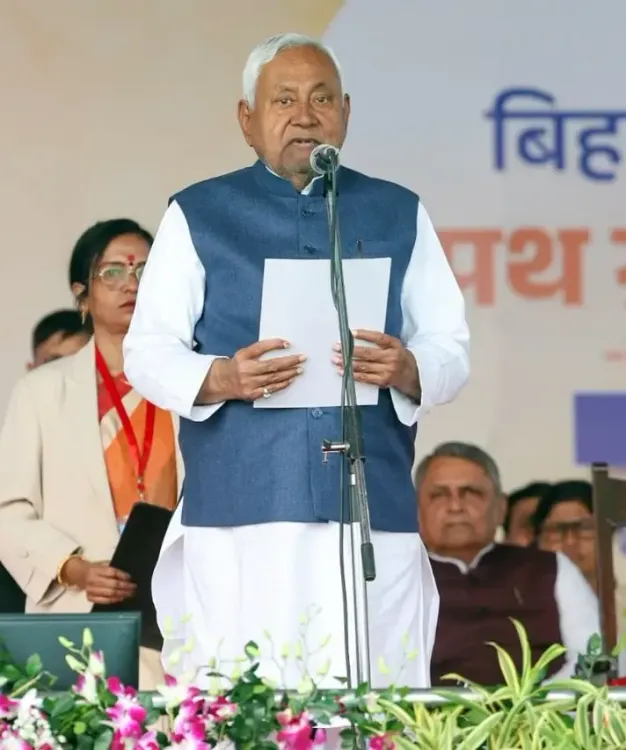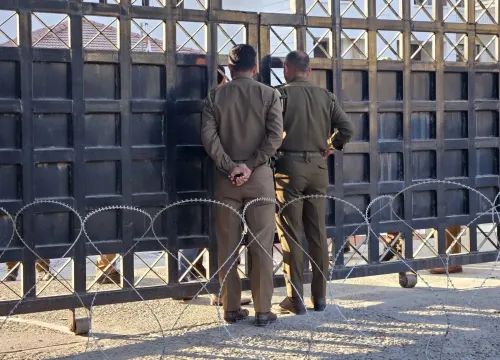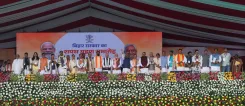How Does a 'Double Engine' Effort in Bihar Silence Critics Again?

Synopsis
Key Takeaways
- Nitish Kumar's 10th oath-taking marks resilience in Bihar politics.
- He has navigated complex alliances throughout his career.
- His governance has led to significant infrastructure and reform achievements.
- Challenges in health and education remain pressing issues.
- His legacy positions him among India's longest-serving Chief Ministers.
Patna, Nov 20 (NationPress) “I, Nitish Kumar…” At 11:35 a.m. on Thursday, November 20, the skeptics watched in silence as he took the oath of office and secrecy for the 10th time as the Chief Minister of Bihar. Up until that moment, there was a chorus of doubts regarding whether the Bharatiya Janata Party (BJP) would permit the 74-year-old leader of the Janata Dal (U) to head the National Democratic Alliance (NDA) state government “this time.”
Similar skepticism arose in 2020 before Nitish Kumar was sworn in as the head of the state government, with a mask symbolizing the first democratic process held in India following the Covid pandemic. Regardless of whether the JD (U) secured 43 seats in the 2020 Assembly election or 85 in 2025, or whether the ally returned to the Bihar Legislative Assembly as the third or second-largest party, the BJP remained committed to its pledge of a government led by Nitish Kumar.
Throughout his extensive political career, the JD(U) leader has been affiliated with various parties. Born on March 1, 1951, in Bakhtiarpur, Nitish Kumar emerged from the socialist tradition and entered electoral politics during the 1970s, advancing through organizational roles in Janata Parivar formations and later the Janata Dal (United).
His first significant executive success occurred in 2000 with a brief term as Chief Minister, then representing the Samata Party. He returned in 2005, forming a stable government that marked the beginning of his public image as a leader focused on governance and law-and-order reform.
Over the next two decades, Nitish combined electoral appeal with frequent recalibrations of alliances, alternating between partnerships with the BJP and opposition coalitions as political circumstances changed. He has held multiple terms as Chief Minister, building a reputation for administrative interventions in infrastructure, rural electrification, road construction, and public distribution reforms, earning the nickname of “sushashanbabu” or Mr. Good Governance.
His strategy blended technocratic initiatives with caste-sensitive political engineering, helping to maintain a broad, albeit sometimes shifting, support base. His former colleague and now adversary, Prashant Kishor, famously remarked in Hindi, loosely translated as Bihar flourishes under Nitish Kumar.
Journalist Sankarshan Thakur aptly named Nitish Kumar’s biography ‘Single Man’, describing him as “a cautious man, often overly careful, unwilling to tread on uncertain ground.” The book recounts that in 1992, Nitish Kumar was not even on speaking terms with Lalu Prasad and had a notably ugly confrontation.
Conversely, he firmly opposed Narendra Modi as PM in 2014. However, he has allied with both leaders at different times, even while heading the state government. The veteran politician has a tendency to voice his opinions, sometimes politically incorrectly, which he justifies as “following my conscience.”
Recently, the septuagenarian faced ongoing administrative challenges in sectors like health, education, and employment. Nitish Kumar already holds the distinction of being the longest-serving premier of the state, and upon completing a full five-year term, he would rank among India’s top three longest-serving Chief Ministers.
India’s federal politics present both precedents for long-serving chief ministers and contrasts in style, with leaders like Pawan Kumar Chamling of Sikkim and Naveen Patnaik of Odisha having served over 24 years continuously. Similarly, Jyoti Basu of West Bengal stepped down after more than 23 years and four months in office.
Nitish Kumar has already served a cumulative term of over 19 years and eight months, and the count continues.








